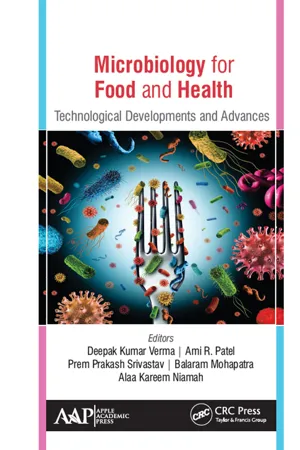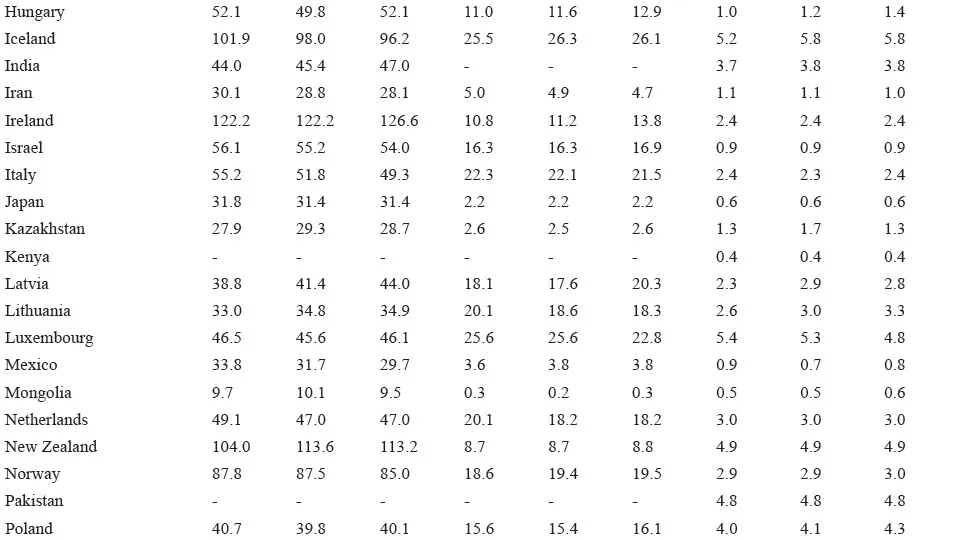![]()
PART I
Technological Advances in Starter Cultures
![]()
CHAPTER 1
Starter Culture and Probiotic Bacteria in Dairy Food Products
DEEPAK KUMAR VERMA,1* AMI R. PATEL,2* JASHBHAI B. PRAJAPATI,3 MAMTA THAKUR,4 ALAA JABBAR ABD AL-MANHEL,5 and PREM PRAKASH SRIVASTAV6
1Agricultural, and Food Engineering Department, Indian Institute of Technology, Kharagpur–721302, West Bengal, India,
2Division of Dairy and Food Microbiology, Mansinhbhai Institute of Dairy & Food Technology-MIDFT, Dudhsagar Dairy Campus, Mehsana–384002, Gujarat, India
3Department of Dairy Microbiology, Anand Agricultural University, Anand–388110, Gujarat, India
4Department of Food Engineering and Technology, Sant Longowal Institute of Engineering and Technology, Longowal–148106, Punjab, India,
5Department of Food Science, College of Agriculture, University of Basrah, Basra City, Iraq
6Agricultural and Food Engineering Department, Indian Institute of Technology, Kharagpur–721302, West Bengal, India
Fermented dairy products (dahi or curd, yogurt, cheese), cereal-legume based products (bread, idli, dosa), vegetables (kimchi, sauerkraut), and meat, as well as fish products, are manufactured using specific microorganisms called as starter cultures at industrial level. Starter cultures may be defined as a group of pure, actively growing microorganisms capable of bringing about desirable changes in the substrate through the process of fermentation. These carefully selected microbial cultures are purposely inoculated in milk to initiate (start) and accomplish the desired fermentation changes during the production of fermented milk products. Starter microorganisms bring about the specific changes in the body-texture, flavor, and appearance of the end product. The inherent microflora of the milk or for instance any substrate may be inefficient, unpredictable, and uncontrollable and generally gets killed by heat treatment given to the substrate. When it is inoculated with a starter culture, which can produce specific characteristics in a controlled and expected manner during fermentation.
Starter cultures mainly produce lactic acid in milk and milk products from milk sugar lactose, which leads or assists to coagulate milk proteins by reducing milk pH. Lactic acid bacteria (LAB) are the main group of food-grade starter culture associated with the development of lactic acid in milk. Apart from acid production, certain starter microorganisms are specifically added for their aptitude to synthesize flavor compounds including diacetyl, acetoin, or acetaldehyde in the fermented product. In addition to the pH effect, these organisms also influence the body-texture of fermented milk products through the breakdown of major milk constituents such as proteins and fats.
In the beginning, this chapter briefly describes the basic microbiological concepts of starter cultures such as their types, classification, different groups, and their presence in diverse fermented milk products of the world. Currently, probiotic cultures also find their way into fermented milk products. These specific microorganisms possess several claimed health benefits for the consumer, e.g., better digestion, improved metabolism of lactose, antihypertensive effect, cholesterol-lowering effect, immunomodulatory, and anti-carcinogenic effect. Probiotic cultures may be directly used in from of starters or as an adjunct with a starter culture of the specific product during the fermentation process.
The details about the probiotics, including their mechanism of action, proven health claims for different probiotic strains and regulatory and legislative aspects have been discussed in the latter part of the chapter.
1.2 HISTORICAL RESUME AND CURRENT STATUS
Fermented milk is of great significance since ancient times due to their attractive organoleptic attributes with a wide diversity of aromas, flavors, and textures apart from preservation. Though our ancestors did not have information about microorganisms’ existence or their activities, they gradually acquired the knowledge to use good quality microflora (LAB and related food-grade microorganism) during the fermentation of milk (Prajapati and Nair, 2008). Accidently, when milk was left at room temperature, it was spontaneously fermented and was used as such or after dilution with water. That may be the first fermented milk produced by mankind. Depending on the microflora of different regions, diverse types of traditional fermented milk have arisen globally. Alternatively, draining of whey from fermented milk has resulted in the development of a new product, for instance, the first cheese that could be stored for several months. It is now easy to understand that fermented milk and milk products were developed as a means of preserving milk and organoleptic qualities.
In the area of microbiology, the lack of precise scientific information was the biggest drawback for the failure and undesirable fermentation in traditionally fermented milk products in the earlier times (Prajapati and Nair, 2008). Eventually, traditional milk products were standardized and to some extent, modified to fine-tune their industrial production. Cheese and butter production became industrialized about two hundred years ago. Storch and Conn in 1890 firstly make use of starters for developing flavor and aroma. Probably, in 1895, the first time the starters were used for cheese making in Britain (Prajapati, 1995). Starter cultures were grown in the production units, but the importance of standardized starters increased as the size of the operations grew. In the late 1900s, companies with specialized in the production of starters (Dannish farm of Hansen, currently known as Chr. Hansen) were founded (Prajapati, 1995). In the beginning, the key constraint was the undefined starters, containing a mixture of various unknown strains. Afterward, starters were analyzed and defined in order to get a specific strain or mixture of several strains having preferred properties to develop a standard product (Yadav et al., 1993). Starter culture industry has undergone tremendous development in the last few decades. Currently, the starter culture market is highly competitive with leading players such as Angel Yeast Co. Ltd.; Danisco A/S, LB Bulgaricum Plc.; Chr. Hansen A/S, SACCO (Italy), Csk Food Enrichment B.V, Lesaffre Group, Dohler Group, Wyeast Laboratories Inc.; Lallemand Inc.; and Lactina Ltd.; which invest in research and development on starter cultures to strengthen their product range.
After the alcoholic beverages, fermented dairy products stand for the second most significant fermentation industry; about 400 diverse products obtained from milk fermentation using specific starter culture are consumed around the world (Chandan, 2006). Along with dairy industry, starter cultures also hold significance in the beverage industry; used in the manufacturing of various alcoholic drinks like beer and wine due to their intense flavor, quality enhancement properties, and other characteristics. According to a recent survey (TMR, 2014) between 2013 and 2018, the market of starter culture is projected to rise at a CAGR of 5.6%. In 2012, the market was dominated by Europe and yeast was the largest segment within the starter industry, both in terms of value and volume. The Asia-Pacific market is anticipated to grow at a rapid growth rate during the forecasting period.
The consumption of fluid milk has decreased during the last decade with a concurrent increase in consumption of fermented milk products, mainly due to changing consumers’ preference and health awareness. The comparative consumption of fluid milk, cheese, and butter across the world is shown in Table 1.1. Based on portability, health claims and snack appeal, yogurt, and kefir are booming the market. In case of yogurt, in United States (US) only the sales are expected to raise from 7.3 billion USD in 2012 to 9.3 billion USD by 2017 as per the recent survey (STATISTA, 2016).
In India, fermented milk products like dahi (curd), buttermilk, lassi (sweetened fermented mill resembling stirred yogurt), and shrikhand (drained/concentrated mass of curd mixed with sugar and flavors) form significant place in a routine diet. Dahi is indigenous fermented milk product of India and nearby countries that has retained its popularity in diet despite modern food habits and changing lifestyles (Prajapati and Nair, 2008).
1.3 STARTER CULTURE IN DAIRY FOOD PRODUCTS
Several starter cultures are used to manufacture diverse dairy products at an industrial level, as shown in Table 1.2. These starters can be grouped under different categories based on the composition of microflora, growth temperature, type of products, flavor production, and type of fermentation as discussed in subsections.
TABLE 1.1 Total Global Consumption of Fluid Milk, Cheese, and Butter from 2013 to 2015
Source: Canadian Dairy Information Centre.



